3B8/ZS4TX 6M EME DXpedition 15-25 September 2016
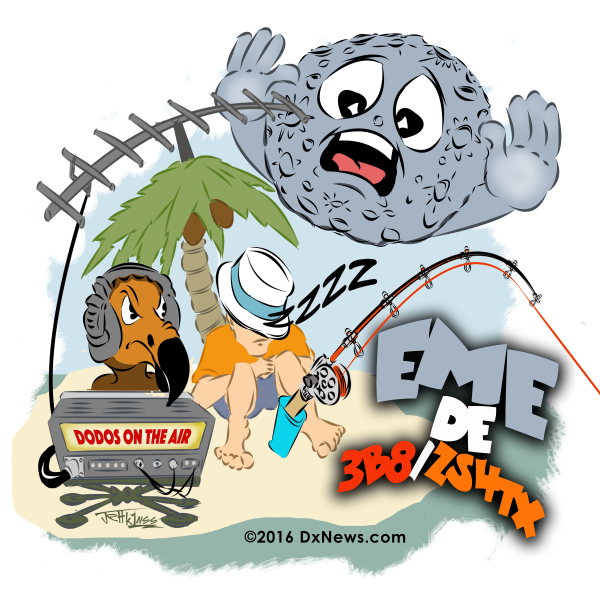
Mauritius Island. 3B8/ZS4TX. HonEMEmoon. Dodos on the air.
Combining a DXpedition with a holiday is always a good idea. This year the choice fell on Mauritius, a perfect holiday destination.
My wife, Ronél ZS4TZ, and I have been to Mauritius a few times before, so there was no need to explore the island this time. The idea was to spend four days at a seaside bungalow on the northwest of the island for the 6 m EME expedition and then move to a hotel further north for the real holiday.
Planning
Preparation for this expedition began in June 2016. An application for a licence was lodged with ICTA, the Mauritian regulator, accommodation was confirmed and airline tickets booked.
My business partner has been to the specific bungalow I had in mind during a holiday about eight years ago. With his detailed pictures, I could plan my antenna installation in detail using existing supports on the site.
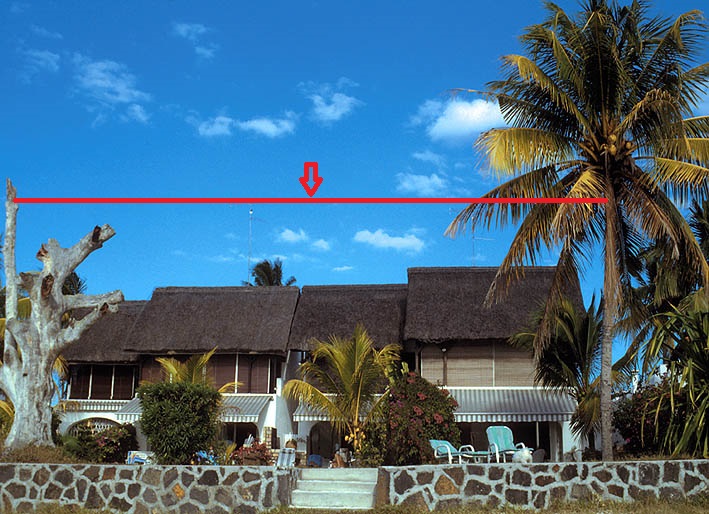
Picture 1. The planned skyhook position.
Despite buying two extra 23 kg baggage allowances, I was unable to include a mast of any sort. I planned to support the 6M8GJ Yagi on a rope strung between an 8 m tall palm tree and a 6 m tall dead tree stump. This rope would give me a solid skyhook around which to manipulate the antenna up to 60° in the moonrise or moonset direction.
The 6M8GJ used during the expedition was the prototype 6M8GJ that was used by Lance Collister W7GJ several years ago during his first few Pacific 6 m EME expeditions. It somehow ended up in Durban for use on DXpeditions. After some negotiating I managed to refurbish it for additional duty, this time in the Indian Ocean. After years of lying assembled and unused close to the coast, it took some work and a few new parts to restore it to a close resemblance of its former grace.
Two weeks before departure, I set up the fully assembled 6M8GJ at my home to simulate the planned rope suspension installation in Mauritius.It worked perfectly. I was copied by several European and North American stations and I worked W9JN, a new state for me and a new DXCC entity for him. I was also getting good signals on my stock-standard IC-7100 without an additional preamplifier.

Picture 2. Testing the 6M8GJ rope suspension setup.
Time to pack!
As the time to leave crept closer and the equipment weight increased, I bought two additional checked luggageallowances. At US$ 50 per extra 23 kg return it seemed a fair deal, and much cheaper than it would be at check-in. The antenna was placed in a golf carry bag with a 2 m yagi antenna on loan from ZS6JON. The idea was to be ready on 2 m for any possible Tropo openings that occur regularly in September between Reunion Island and South Africa’s southeast coast, over distances of around 3200 km. If this path opened to Mauritius, it would have added another 200 km or so to the current ZS-FR distance record. 3B8CW and I were checking the band regularly during my stay. We did not get lucky.
Fortunately Clive, 3B8CW, is a resident with considerable VHF and Digital operation experience.He lives very close to the west coast of the island. He will be monitoring 2 m for any possible openings to South Africa.
Back to the luggage: A golf carry bag is a large item and exceeds the overall dimensions allowed for a standard piece of airline luggage. They did not seem to mind. The golf bag was treated as fragile and hand-carried to the container, unlike the other cases that received the usual airline treatment. The “Tuff Case” containing the radio and amplifier weighed in at 28 kg. After a few minutes of discussion between me and the clerk, the case was also accepted into the fragile bin. All our bags combined just fitted into our full allowance.
Arrival in Mauritius
The four hour flight to Sir Seewoosagur Ramgoolam International Airport went smoothly. Only passing through customs brought a moment of panic. As my prized golf bag and the Tuff Case were listed as fragile, they came in late and had to be picked up in a different part of the arrival hall. This side trip caused a serious delay in us passing through customs with the rest of the crowd. As I was dealing with the Golf carry bag, my wife had the trolley with the oversized equipment case. Not having any place to hide and looking like we were transporting Bulldozer parts she was stopped and I had to turn back to help explain. Fortunately the customs officials knew about amateur radio. They were keen to see the licence. I only had a faxed copy of on my iPhone. After explaining that I will only receive the licence at the ICTA offices the next day and emailing them the copy, my wife and I were on our way. I was not the favourite of the moment…
From the airport in the southeast, it is still normally a 1.5 hour drive to Triolet, the small town where our bungalow was located. The new highway through the centre of the island reduced it to a pleasant one-hour scenic ride.
We arrived as night fell. After unpacking most of our stuff, I realised that the lighting in front of the house towards the beach was sufficient to build the antenna and to set it up for a possible additional moonset opening in a few hours.
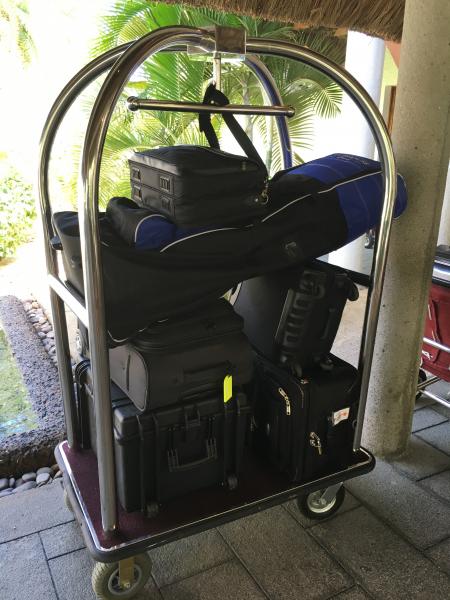
Picture 3. Our luggage.
The Station
Imagine my surprise when I found that the dead tree stump which formed a big part of my “tower” planning was gone! The host had even assured me that the place looked exactly like on the picture she’d sent to me. We were obviously looking at different things in the picture…
I now only have one “tower” which would limit my elevation options, especially towards moonrise, as high elevation was needed to work KH2, ZL, E5 and FK. Towards moonset it was not too much of an issue as my main client base, North America, South America except for a few Northern European stations were mostly only workable below 35° elevation anyway.
While shopping for a golf carry bag I found a 1.1m long golf ball retriever that can extend to 5½ m. This stick proved invaluable for pushing up the rope against the palm tree to get a high enough attachment point for the pulley and rope that supported the antenna. It may even serve as half of a boom for a portable 6m yagi one day.
Suspending an antenna from a tree, although underutilised for sure, is nothing new or groundbreaking. I was first exposed to it during a VHF DXpedition from Botswana in the late 80s, setting up a station with Chris, ZS6EZ and Dave, A22KZ to work W5UN on 2 m for one of Dave’s last few countries for 2 m DXCC. Having flown to Maun with a small plane we also had to rely on supporting the 13 element yagi from a small tree close to the house where A22KZ was staying. Everything, including the feedline and AC extension was stretched to maximum to reach the tree. As the tree was not 100% upright Chris used a rope to adjust the tree for perfect zero degree elevation.
This time, being “Chris-less” and without major tree-bending skills I had to use what was available “un-bended”. The first attempt to hang the antenna from the palm tree would not win any prizes in an Antenna-supported-by-a-palm- tree contest, but it proved to be good enough to kick off the expedition.
Installing the rope at night meant I could not get it up very high.The first moonrise operation was to bedone with the 6M8GJ at 2.5m above ground and the boom pretty much resembling a long aluminium banana with spikes.
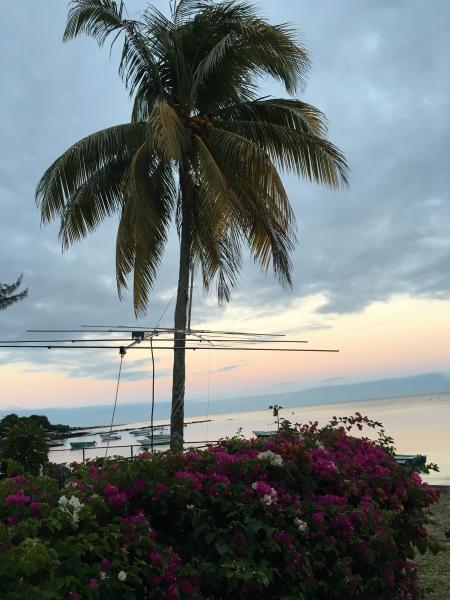
Picture 4. 6M8GJ first attempt at installation.
Testing the station
After pulling up the antenna I quickly assembled and connected the other hardware only to find that I was not hearing any noise on the band at all. Tuning up and down the band did not bring up any birdie or sound as I had expected. I tested the SWR with the IC-7100. The SWR was perfect as I set it at home. I was getting worried and considered asking 3B8CW to loan his radio, also an IC-7100. I removed the antenna from the radio and I only saw a 2dB drop on the WSJT noise level indication. Usually at home on a very quiet day, I get at least 5 to 6 dB of difference.
With nothing much else to do and as it was getting late, I dropped the antenna to ground and went to sleep. Before that I placed a note on the KST EME chatroom to indicate that I will be on earlier than anticipated in case anyone was still around. I did not have high hopes though. After all, my receiver appeared to be broken.
Action!
At 04:00 local time (midnight UTC) on the 16th, I woke up, pulled the antenna into position and elevated it to about 30° by tying it down to an umbrella stand below the reflector. The full moon was clearly visible and the cloud cover was minimal. No wind was blowing so conditions were ideal, except that I still had a feeling that something was wrong.
I took my time outside to secure everything as my operation would only start at 00:30Z and went in only to see several birdies on the screen as I walked in. As I pressed Erase and Clear Average I realised, much to my surprise, that W7JW and S57RR were burning tracks on my screen calling me just before sked time! I waited for the next over to decode Jeff again and he decoded my OOO on the first transmission. The radio was working! His response on the KST chat page that I viewed later was priceless!
The JT65 QSO with Jeff, W7JW, upon investigation, proved to be the first USA to 3B8 QSO ever on 6 m. Fame at last!
As I completed with Jeff, S57RR faded out and W1JJ, UR0MC and K2ZD followed in quick succession in the first 20 minutes. F6BKI with his, now famous, cross pole array made it in the log an hour later when I dropped the antenna to 0° elevation. That was it for the day.
As Lance, W7GJ suggested, the point to adjust to the 0°level is around 20°moon elevation, depending on the location. With my installation at a lower height, I found that at around 15° I had to tilt the antenna to the horizon to be able to follow signals.

Picture 5. First day - working W7GJ.
The Station 3B8/ZS4TX
Having used an Icom IC-7100 for a few years at my remote site in ZS6 for TEP purposes, I was confident in using the 7100 for this expedition. The IC-7100 is lightweight, has HF up to 70 cm and can operate without the control head, making it an ideal expedition or remote installation radio.
The recent amendment to the Mauritian Amateur Radio Regulations now allows 800 W on most bands and the ATLAS 1000 was perfect for the job.
The IC-7100 and the ATLAS1000 remote displays made for a neat table top installation.The “power tower” was set up on the Tuff Case on the floor allowing easy access for the 20 m long semi-rigid SA10172-B11 feeder cable.

Picture 6. ATLAS 1000 control head.

Picture 7. Notebook, IC 7100, ATLAS 1000.

Picture 8. RF Amplifier, Radio and Power Supplies.
At Moonrise on the 16th, I made an attempt to elevate as high as possible for ZL, KH2 and FK.Unfortunately, I could only achieve 35° while at least 60° were required. Even so, I managed to get two decodes from Warwick, E51WL at his moonset but unfortunately no QSO was made. The moonrise direction was also slightly obscured by palm trees and I had to point the antenna over the residential area, which added slight noise.
ICTA and the Mauritian government can be commended for not allowing the usual flood of Noise generating Wireless devices to take over the HF and VHF spectrum as in many other places. Most of the residential areas have Fibre to Home internet connections and although the streets look like Spiderman passed there recently,fibre does not present all the noise that DSL or Wireless does in other locations.
The only noise I experienced while beaming out over the ocean to the West was 60 seconds of ignition noise from an old car starting nearby every morning at 06:00 to go to work. The rest of the time it was just unimaginably quiet. No wonder I thought the radio was broken at first!
ZL3NW, ZL2DX, KG6DX and FK8CP joined E51WL on the list of unworked stations as I could not elevate the antenna higher than 25 towards the Mauritius moonrise direction to compensate for their horizon-only arrays.
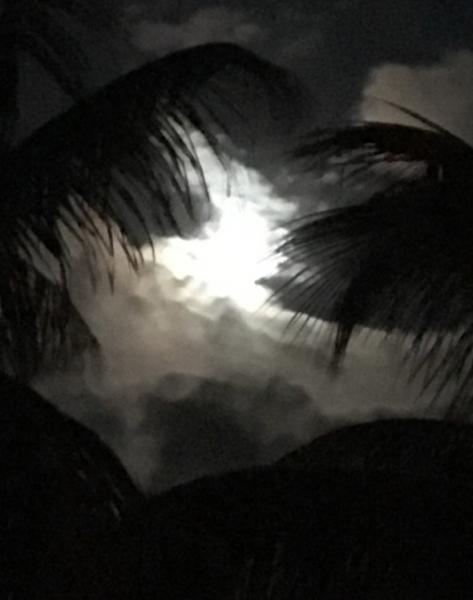
Picture 9. Moon elevation 30° towards the East.
Stations in the US Pacific Northwest were also excluded from a proper attempt at working me partly due to the timing of the trip which made the common moon window to some stations very small or non-existent. Future efforts from 3B8 may benefit from a site on the northern tip of the island with sea-horizon visibility to moonrise and moonset at a time of high northern declination. Having a low moonrise over the sea will enable the W6s and 7s to have a chance at their moonset as well. 3B8 being almost antipodal from southern W6 definitely presents some real EME challenges for that area.
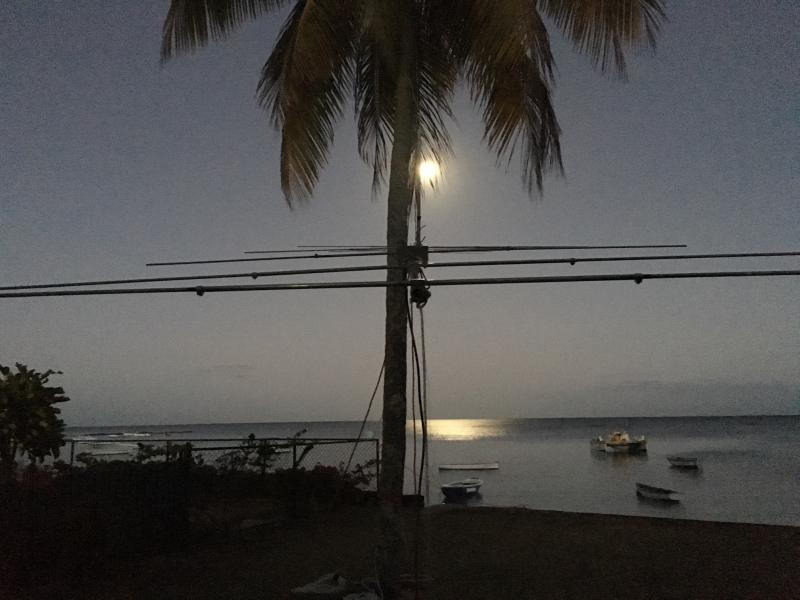
Picture 10. Moonset around 20°.
Day 2
The Moonset window on the 17th brought QSOs from N3XX, ZS6NK, OH2BC, K4PI, W5ADD, G8BCG and W9JN in quick succession. OH2BC was -13 dB at times, an amazing signal considering the small hardware on my end. G8BCG was answered when there were no NA callers visible as he has 3B8 already confirmed via the ionosphere. S57RR was also seen calling but unfortunately every time when I had the option to select an NA station as well. For OH2BC it was a new DXCC entity.
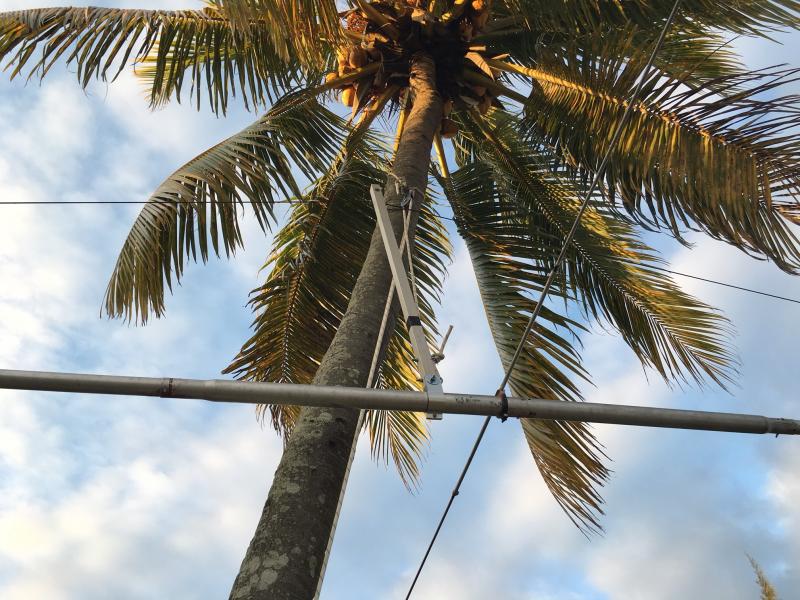
Picture 11. 6M8GJ Suspended from palm tree.
Day 3
Starting earlier than advertised, with the moon not visible in NA yet, I managed to work S57RR with his usual big signal. About 40 minutes later the opening to NA yielded QSOs with W8PAT, N8GTI, KJ9I, W3UUM, N9IW, W9GA, ZS4TX [guest op], N8JX, ES6RQ and just when I thought the propagation was gone at around 1° left, I received the 73 report from K9TVG! Eleven contacts for this opening. It was getting better!
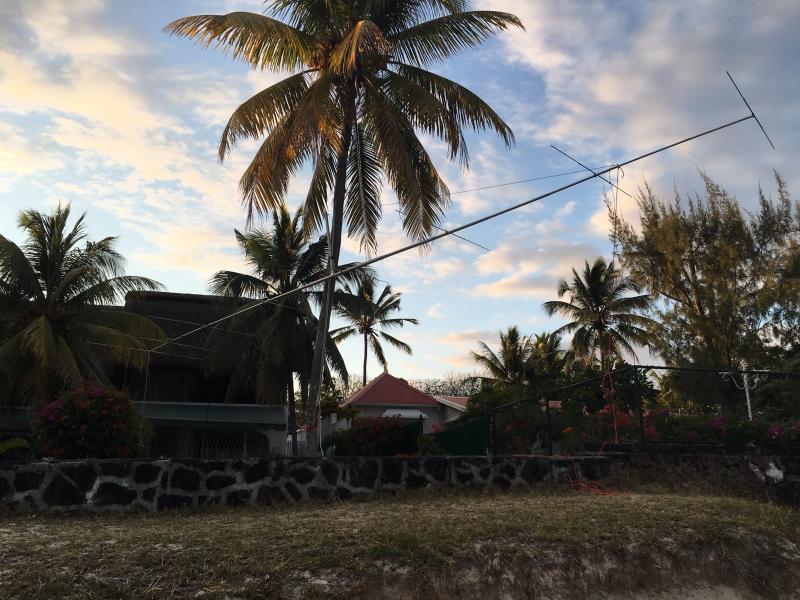
Picture 12. 6M8GJ in full flight.
By now I had a better understanding of where to point the antenna at different elevations for optimum performance. I set up the notebook as a Wi-fi access point and by using VNC on my iPhone I connected to the notebook to view the WSJT spectrum screen. This meant I could stand right at the antenna and manipulate the elevation to see where the signals are the strongest.
Day 4
On 19 September, moonrise at my location was close to sunrise so it allowed me to take better pictures of the antenna setup. I used two 12 m long 13 mm climbing ropes, a lightweight pulley and a combination of slings, carabiners and shackles to hoist the antenna up along the Palm tree.
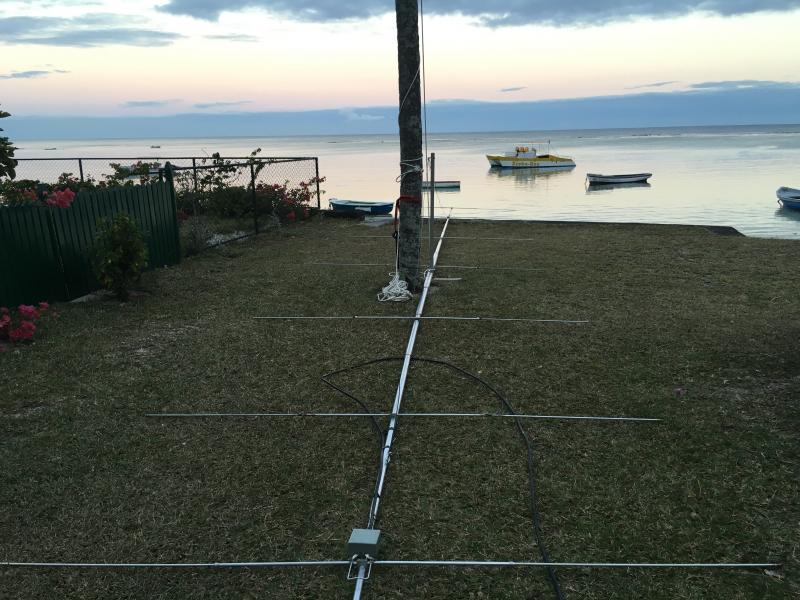
Picture 13. Antenna in <rest> mode.
The Palm leaves affected the performance of the antenna when they touched the elements, so when I elevated higher than 30°I had to drop the centre attachment point of the yagi lower to avoid high reflected power.
Dropping the reflector to within 30 cm of the grass made no detectable difference in performance. As the moon went lower, I was again able to lift the centre of the antenna to about 5 m above ground, hoping to drop the final lobe to at least zero degrees or lower.
Dennis, NT0V, was the first in the log followed by VE5UF and then WA4NJP, whom I saw for short times every previous day but we were never in propagation sync to make a contact. S59A called me at a quiet time a few minutes before moonset followed by W3XO and SP3RNZ, with a single yagi, almost at moonset.
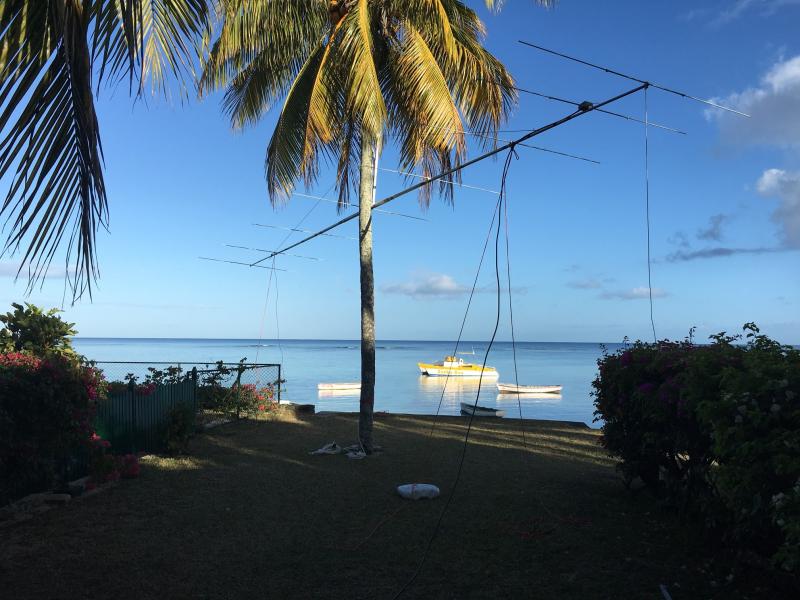
Picture 14. 6M8GJ in "Montana Mode".
The last few minutes to moonset were spent looking for Lance, W7GJ who had about 4 minutes of half a common moon to 3B8. I decoded Lance twice, the first time at -26 and at -29 dB at my -1° degree moon elevation. Unfortunately, my 800 W did not make the grade at the time. Fortunately another opportunity presented itself later and Lance and Bob, N7IP also made it in the log.
At this stage of the DXpedition,the palm tree must have had enough because as I lowered the antenna to ground, the rope at the top slipped and I had to catch the antenna with both hands as it dropped a meter or so in freefall, followed by the small pulley that chose to strike me on the head. The few drops of rain we had during the night must have made the tree very slippery.
As if that was not enough, while walking back to the shack, licking my wounds, the smaller palm tree that was used on 2 m as a support released a green coconut of about 2 kg to stop me in my tracks. Nature had spoken loudly and clearly: In future I will add a hard-hat to the equipment list!
2m EME
The expected troposcatter opening to South Africa did not realise.On the 18th at 23:00 UTC, before the 6 m skeds started, I decided to see if I could receive any 2 m signals off the moon. The antenna, a nine element lightweight yagi, was one single plane section of the four-yagi cross-polarised array that ZS6JON used at his home station for a while after the very successful Z21EME VHF EME expedition.

Picture 15. ZS6JON super Moon Magnet 2m yagi.
The yagi is extremely lightweight and was easy to install using a plastic chair as base and yes, you guessed right, another palm tree to act as elevation support!
Great was my surprise when I found PA5Y calling CQ at -23 dB, about 8 to 10 dB down from his usual signal at my home station. I decided to give him a call and eventually after a few tries, Conrad decoded me and we exchanged reports. Conrad’s legendary receive capabilities on 2 m EME helped him to another new entity on his way to 2 m DXCC.
I had received several requests for 2m EME skeds from 3B8, but unfortunately I was not able to carry enough equipment along to set up a proper station to afford a fair chance to everyone. Mauritius has been activated on 2 m EME a few times but many stations, including myself, still need it for a new entity. Maybe next time.
Accomodation
 |
|
Picture 16. ZS4TX at sunset.
Our accommodation was a very basic but functional two bedroom bungalow with a large living area, TV room and kitchen. The spectacular views and sunset over the Mauritius coral reef made up for the creaking stairs that woke theneighbourhood up at 2 AM while I was getting ready to operate.
A nearby supermarket provided the general foodstuffs.We also had a Restaurant within walking distance, operated by people who moved from South Africa to Mauritius 9 years ago. The cost of food varies between 30 and 70% more expensive than at home, as much of it is imported.
The following five days were spent at the Hotel Le Cannonier, further up the coast. This hotel has all the “towers” for a Multi Multi VHF DXpedition but the location of the rooms and the pathways between them and the seafront would make a semi-permanent setup difficult.
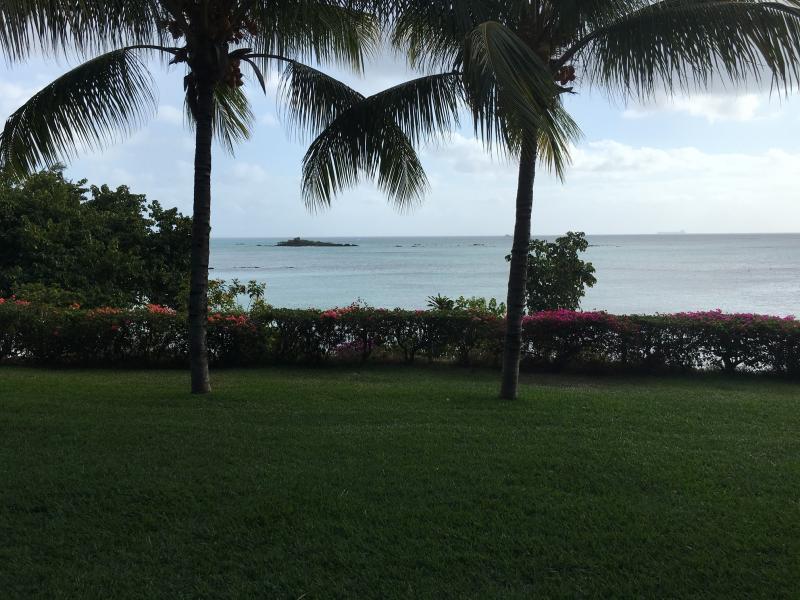
Picture 17. "I see Towers ....." Moonset direction at Hotel Le Cannonier.
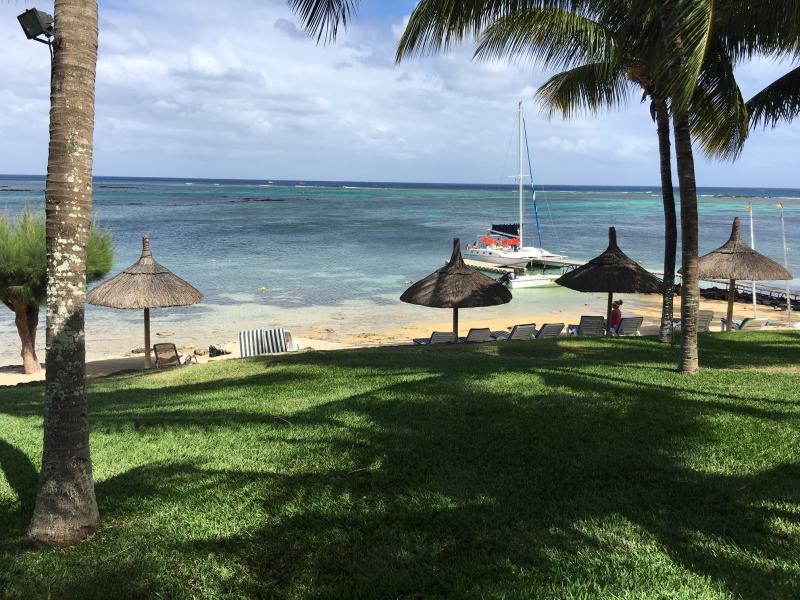
Picture 18. Direction 3B6 Agalega 1070 km.

Picture 19. The deck above Yacht Club at Le Cannonier. An ideal EME setup location as it is rarely occupied.
Departure
Our departure from Mauritius was also not without incident. We arrived early enough at the airport to avoid any possible delays with the oversized luggage.All went well, even after they asked me where the bicycle was that I wanted to check in as noted by SAA on their system! This time I spread the load between all the cases to avoid any single overweight case.
As we went through customs and were waiting in the boarding lounge, ready to board, my wife was summoned over the intercom to present to security. Feeling guilty I accompanied her to security. We were taken down a long hallway to an office where the Tuff Case and one other case were lying on a table, obviously being flagged and directed off the loading carousel. After opening the cases and some explanation about amateur radio the officials were happy and the luggage loaded. Although I was [again] not the favourite person of the moment, the officials were very friendly and it is good to know that they are taking their job seriously.
The golf bag was again handled with the utmost care by the staff at the airport. I guess with golf estates forming a huge part of the Mauritian income stream, no-one wants to be known as the guy who broke a famous golfer’s clubs!
Summary
While 31 EME QSOs on 6 m and one on 2 m will not place this effort in the record books, it was a fantastic experience adding to my limited experience on VHF and especially EME. Handing out 3B8 for an all-time new one to North America on 6 m was a definitive highlight. Thank you very much to the European stations not needing 3B8 for affording me the chance to work so many NA stations.
I also met Clive, 3B8CW, while on the island. Clive has a comprehensive telecommunications background and has shown lots of interest in the EME setup. Maybe we will see him off the moon soon!
Bernie van der Walt ZS4TX
2016. 10. 07


